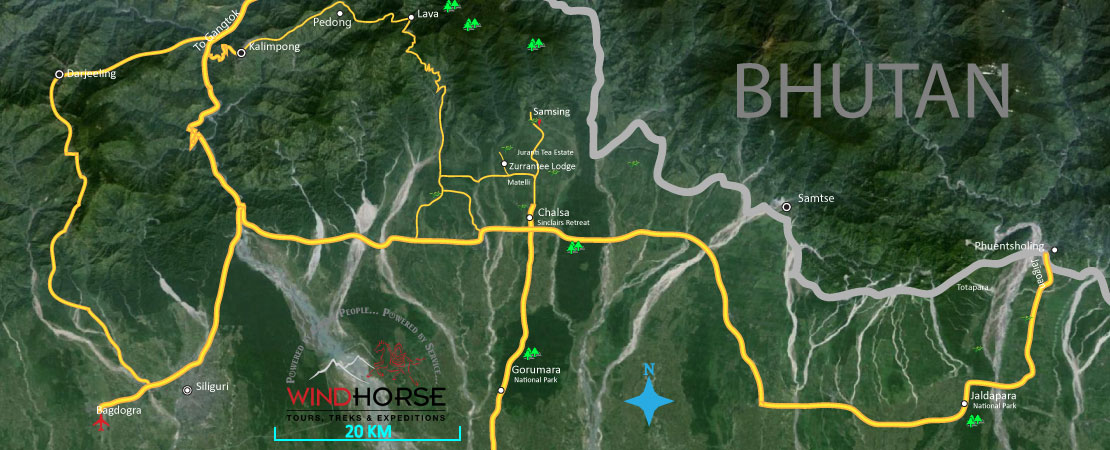Duars or Doars : From Tourism Perspective.
The Dooars or the Duars and also Dooars, is the stretch of flood plains in the Indian state of West Bengal. It stretches as far as 130 kms by 50 kms approx, rolling out to meet the adjoining foothills of Darjeeling, Kalimpong, Sikkim and Bhutan. In fact its name is derived from ‘doors’, meaning gateway to the mighty Himalayas.
This alluvial plain houses some of the significant national parks and wild life Sanctuaries of India namely, Jaldapara, Gorumara, Buxa Tiger reserve. More than a way its serves as a biological corridors for the wild life that pulsate and thrive in these sanctuaries. Moreover, lush green tea garden that covers the region extensively add to its natural beauty and also invariably provide a feel that is so intrinsically different from rest of India.
Besides National Parks, Wild life Sanctuaries and Tea Gardens, one remarkable aspects that set it apart is its ethnic and cultural diversities. To put into perspective, absence of industries to provide peace to the wild life, lush green vegetation, remoteness to a larger degree have denied the far reached of modernity to influence their lives which in a way has sustained in retaining the quaint and tranquil charms and the natural beauty of the specific region to an extent that it takes you back in days of yore. Where simplicity and naturalness was the norm of the day. With this attributes and its own local history, it can significantly encompass manifold aspects associated with the areas.
Duars regions harbour many tea gardens, which is the major contributor to the local economy. Tea was planted by British during their colonial days. Each tea estate brought thousands of employments, that attracted worker of different ethic background from far and near. This pave the way as melting pot for people from different cultural, religious and ethnic background . You will be amazed to see a diverse culture and religious practices with in a few meters of walking distance. Many of these tea-estates had large bungalows for their Manager, or British Sahib (lords), and for their guests. Some of these bungalows are well maintained, and few are now converted to into heritage hotels . One of the name that comes to the mind instantly is the Zurantee Tea Lodge, located on crest of scenic hill top, surrounded by lush tea gardens. The nearby tea factory provide employment for thousands, and in a way, live in their own world; with their village school, hospitals, shops, play grounds, far removed from the hustle and bustle of city life. On the fringe of these tea garden and national parks, you will come across many villages with their own source of livelihood in form of agriculture and sustenance based in forest. The life in these village are simple with very basic need and means for sustenance. The villages and daily lives still depicts the picture that is far removed from daily grind of modernity. The kids go to school merrily where their class are held in open air under the tree. When people in modern world talk about Concorde for travelling you will see people cycling their way to make their living. They live in harmony not only among themselves but with surrounding nature and its elements. And what speak volume is the countenance in people that reflects peace, tranquility which sometime inspire us to take a few leaf from their books.
At Wind Horse we strongly feel that these places are more than worthy of few days stopover, and certainly more so if you are travelling in Bhutan and or Sikkim/Darjeeling areas. Luxury accommodations are not available, but hotels such as Sinclair Retreat and Zurrantee Heritage are more than average, and their location on hilltop amidst bountiful nature and tea estate, next to remote villages with options of visit Wildlife Sanctuary nearby, more than make up for the missing luxury.C
Climate : Due to abundant vegetation, even the summers feel remarkably pleasant, with pervading cool breeze. With onset of Monsoon, it not only brings down the temperature, its bring greenery every where, giving a new lease of life to tea . Its a visual treat to see worker in action plucking fresh tea leaves and it is also period of time when tea processing activities gather momentum. Arguably, winter or more specifically from end of October till March is the best time to visit, with temperature at its best. The day temperature are between 55-70’F in the main winter months (late November through end of February) and with hardly any humidity in the air, it just feels great.
Adding this brief sojourn can enhance your experience in more than a way. Most significantly aspect is it add an element of diversity in your experience. Unique and complete departure from the experience that you will encounter in the hills of Sikkim, Darjeeling and Bhutan. In nutshell, it has all the ingredients to make your experience memorable. We will bring to local villages, chat with them and children, visit tea estates and factory.


